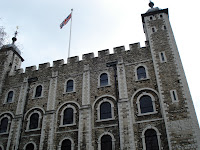It was my first time seeing Caribou, masterminded by multi-instrumentalist and vocalist Dan Snaith, in a live capacity. Even though I don't fall into the category of die-hard fan, I was curious to hear how the music translated live. I'm happy to report that those of us attending the concert were not left disappointed, as many of the songs sounded even better than their studio counterparts.
The set up was simple enough. Snaith and three more musicians (Andy Lloyd, Ryan Smith, and Brad Weber) played a set of approximately 90 minutes, rarely pausing to speak to the audience and barely creating a scene. Psychedelic graphics were projected onto a backdrop, mirroring the sixties-inspired aspects of Caribou's music.

The music itself was gorgeous, with lush and textured instrumentation by a band that clearly wants to sound its very best. The setlist included a variety of songs from Caribou's catalogue including the breezy "Melody Day," "Sundialing," and the recent single "She's the One" from 2007's Andorra. While there were a few occasions where the vocals seemed to get drowned out by the instrumentation, this didn't hurt the songs' overall sound, especially since the vocals don't tend to be the main focus of Caribou's music.
The percussion was easily the highlight of the night, with the drum kits set up right in the middle of the stage. Drummer Brad Weber was a powerful performer who only broke out of his trancelike state a few times to smile for an appreciative crowd. The intensity of his drumming increased throughout the night and at one point, culminated with him actually clamoring on top of his drum kit with concertgoers shouting, "Incredible!"

And of course, Snaith was equally inspiring throughout his performance, deftly switching from guitar, to keyboard, to drums throughout the night — he even whipped out the woodwinds at one point! But once again, it was best when he took on the drums, going head to head with Weber. The dueling-drum effect had the whole crowd bopping their heads and swaying to the rhythms. I've been to other shows with incredible drumming, but this was one of the first times I found myself so fascinated by it. It's pretty rare for percussion to be given the front-and-center treatment, which may be why I found it so mesmerizing.
Caribou ended the night on a high note, coming back for a one-song encore where a bandmate announced that Snaith had turned 30 years old while performing on stage. After yet another energetic percussive performance, the band left the stage, to cries of "Happy Birthday!" from the crowd.
The Fuck Buttons, who opened for Caribou, were also pretty fantastic and eclectic. Using electronic equipment and percussion instruments, the duo played a gapless 40-minute set that combined tribal rhythms, the sampled sounds of spacey chimes and grinding guitars, along with angry distorted vocals that never detracted from the music itself. The set maintained a moody atmosphere throughout, even as it grew increasingly energized via the presence of thumping beats.
The act was able to get a somewhat positive reaction out of some audience members, which is a promising sign considering how many opening acts have left the crowd cold at other concerts I've attended. Though the set did feel like it was dragging slightly towards the end, the Fuck Buttons put on a strong performance, contributing to a great night for music fans who were looking for something that was both fun and experimental.
(You may also check out this review here).











